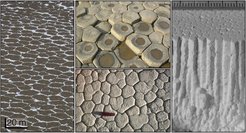Cracking mud, freezing dirt, breaking rock
fascinating similar pattern
What do a broken-up mud puddle, patterned ground on Mars, and the scales on a Nile crocodile have in common? They are all examples of ordered patterns of cracks, as demonstrated in the figure below. Similar patterns may appear in the structure of veins in leaves, while cracks in dried blood can be used for forensic or medical diagnostics. Interpreting complex networks of crack patterns, like these, has remained something of an art. The recent article in Physics Today shows how all these patterns are, in fact, generated from the same basic mechanism, and shows how their patterns can tell the story of their formation. The key physics can be described by simply considering a mud puddle, as it dries.
As wet mud dries, it shrinks. Cracks appear, one by one, and grow across the mud until they hit something, like another crack, or they run out of mud. When they hit another crack they will tend to turn towards it, joining at two right angles. This lets the new crack release as much energy as possible, from the shrinking mud. After many cracks form they make a network where the cracks enclose 4-sided figures, bounded by right angles.
This, however, is not what is seen in the patterns below. In all these cases, there is an additional feature – time. In frozen ground the annual cycles of summer and winter heal and break the ground; the patterns we see have formed over thousands of years (at least!). The cracks in dried mud can close together when it rains, or when a scientist sprays water over them, and then re-open when the sun shines again. In the columns of lava or starch, the cracks can evolve as they grow into the third dimension. In each season or cycle the cracks reappear, at roughly the same location as before, but can change their shape slightly. The right-angled pattern is a record the original sequence of cracking, but this sequence will be different in each cycle. Over time these differences accumulate, and stretch the angles into 120°, with the cracks forming nearly regular hexagons, which is an average over all possible sequences of cracking.
A thorough understanding of this mechanism potentially allows, in return, to draw valuable conclusions from observed patterns of this kind. For instance, the honeycomb patterns observed on Mars do not only show that conditions there have remained unchanged for thousands of orbit revolutions around the sun, their size also allows to estimate the thermal conductivity of the rock material, and thereby gain valuable information about its constitution without undertaking the difficult task of landing there and taking samples.

